Partition of Bengal 1905 - Summary
The Partition of Bengal in 1905 represents a pivotal moment in Indian history and was a significant territorial division driven by the British Raj. This change, effective from 16 October 1905, drew a line between the largely Muslim eastern regions and the predominantly Hindu western regions of Bengal, an announcement that was made by Lord Curzon, the then Viceroy of India, on 20 July 1905.
The Reaction to the Partition
The Hindu community in West Bengal, who played a vital role in the region’s economy and rural activities, were deeply concerned. They feared becoming a minority in a province that would include Bihar and Orissa. Many Hindus viewed this move as a “divide and rule” strategy, aimed at weakening their united political strength. Despite Lord Curzon insisting that the partition would enhance administrative efficiencies, the public sentiment was decidedly against it.
The Motives Behind the Partition
The true intentions behind this significant reorganization have been debated. In two letters from Lord Curzon’s Home Secretary, Herbert Risley, dated 7 February and 6 December 1904, he expressed that a united Bengal posed a threat to British governance. He stated, “Bengal united is a force, Bengal divided will go in different ways,” highlighting that creating divisions would serve the British agenda by fragmenting opposition.
The partition inspired Muslims to organize along communal lines, and in response to widespread unrest, the British authorities reunited Bengal in 1911. This decision was influenced by the anger and protests arising from the Swadeshi movement, where individuals believed that their identity and administrative rights were at stake.
The people of Bengal viewed the partition as a betrayal of their homeland and a strategy to diminish their power. In the lead-up to the division, the Indian National Congress organized numerous meetings to gather petitions against the division, presenting them to the indifferent authorities. Notably, Surendranath Banerjee proposed separating non-Bengali regions like Bihar and Orissa instead of splitting the Bengali-speaking community, but his suggestion was dismissed by Lord Curzon.
As the partition date approached, Banerjee recognized the ineffectiveness of petitions and turned to stronger measures, advocating for the “swadeshi” movement, which encouraged boycotting British goods. This approach gained traction among not only the moderates but also more radical groups.
Banerjee insisted on expanding the boycott to include government schools as well. On the day of partition, 16 October 1905, schools and shops were blockaded. The police and military responded to clear the demonstrators, leading to violent clashes that caused worry among the older Congress leaders. Consequently, a consensus was reached to call off the school boycotts. The Congress leadership, including president G.K. Gokhale and others, felt hopeful after the appointment of John Morley as Secretary of State for India, believing he would empathize with the Indian middle class and potentially reverse the partition.
You can download the Partition of Bengal 1905 in PDF format using the link given below.
